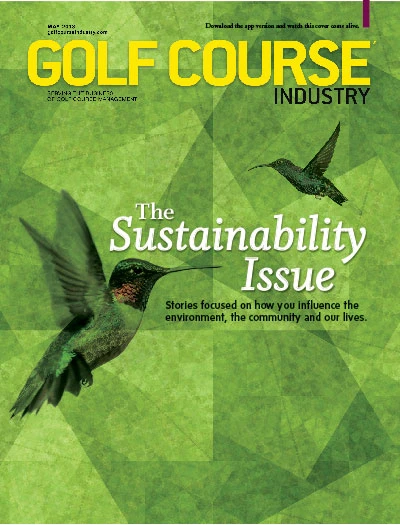 Monroe Miller Monroe Miller |
I cannot recall when I first heard the word “sustainability,” but it wasn’t very long ago. Maybe that’s why I’m not sure what it means in golf course management. Despite my efforts to find out what the definition of sustainability is, it remains elusive. Nearly every superintendent I put the question to gave a different answer... or shrugged their shoulders. There were, though, a number of recurring themes. Almost all suggested sustainability relates to environmental protection in some fashion. I believe this is accurate. Likewise, sustainability implies working toward minimizing inputs. This makes sense, too. Concepts such as water and energy conservation, recycling, adopting new technology, and using inputs that reduce or eliminate adverse effects fit into the definition. Some superintendents said sustainability simply means thinking long term in their management plans. Others felt sustainability requires a strong economical component, too. My conclusion: “They’re all correct.” In fact, my generation practiced sustainability before it was cool. Nearly every time I’ve spoken to turf students, I mention that one of my goals and challenges was to become self-sufficient. This doesn’t define sustainability, but it’s part of the definition. We were working on combining environmental responsibility with good business sense to provide the best product to our players. To me, sustainability is a contemporary word that applies to many long-standing management practices. When I look back, many examples of sustainable maintenance come to mind. Our course has many mature trees. They are beautiful and well placed and add immensely to the game. But the leaf problem in the fall is significant. Despite that, we have never owned or used a leaf sweeper or any other leaf-removal equipment. We were successful in mulching these leaves in place. The leaf mold returned plant nutrients to the soil and helped maintain a healthy microbiology of the soil where these stately old oaks have been growing for, literally, hundreds of years. Fuel was saved by not hauling them to a landfill or back to a compost area. The equipment was simple – blowers and mulching screens on rotary mowers did the work. Certainly, sustainability applies to the way we addressed the leaf drop. Much of the tree work required was done in-house. The wood chips created from tree trimming were mulched or composted. Trees that were cut down provided firewood for the clubhouse. It all seems a really good example of a sustainable program for woody plants on the course. Early on, some annual beds were sodded shut and others were planted with perennials. Annual beds provided fresh-cut flowers for dining tables. Also, for years the kitchen used a perennial herb garden in its menu. I have heard stories from the early years of our course – 1920s – about hauling manure from the county fairgrounds to spread on fairways. We never went that far, but we did haul cow manure from a dairy for inclusion in our compost pile. It represents terrific recycling and is obviously a sustainable product. As time passed, spoon-feeding turf came into practical use, and it can be argued spraying nutrients greatly reduces fertilizer use. Well-managed courses always base fertility programs on soil tests, and many have made good use of tissue testing, as well. GDD research, infrared technology and more add to sustainability. There are hundreds of such practices superintendents already use that fit the term sustainability. Hauling clippings from fairways to a manure spreader and spreading them in rough areas instead of land filling is sustainable. A club invests in irrigation technology to reduce water use is acting in sustainable way. So is the course that hand waters during stress periods. Recycling scrap metal, incorporating IPM into course management, and spot spraying dicot weeds in the spring all qualify, in my mind, as sustainable practices. Sustainability isn’t a philosophy meant to return us to mowing roughs with a Ford 8N tractor and Worthington Airfield Blitzers, or watering fairways with Rainbird 808 sprinklers and quick coupler keys, or spreading horse manure on our tees. And I do not believe that a sustainable golf course is one of lesser or inferior quality, either. It does imply that we need to continue our focus on efficiency and responsible systems of maintenance and management. All we have to do is to continue our dedication to research and education, and to optimize the technology available to us. Just like we have done so well for so long. |
Get curated news on YOUR industry.
Enter your email to receive our newsletters.
Explore the May 2013 Issue
Check out more from this issue and find your next story to read.
Latest from Golf Course Industry
- LOKSAND opens North American office
- Standard Golf announces new product lineup for 2025
- The Salt Pond taps Troon for management
- KemperSports selected to manage Swansea Country Club
- From the publisher’s pen: Grab that guide
- Introducing our April 2025 issue
- South Carolina leaders honor golf course superintendent
- One and only





